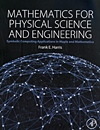- About MAA
- Membership
- MAA Publications
- Periodicals
- Blogs
- MAA Book Series
- MAA Press (an imprint of the AMS)
- MAA Notes
- MAA Reviews
- Mathematical Communication
- Information for Libraries
- Author Resources
- Advertise with MAA
- Meetings
- Competitions
- Programs
- Communities
- MAA Sections
- SIGMAA
- MAA Connect
- Students
- MAA Awards
- Awards Booklets
- Writing Awards
- Teaching Awards
- Service Awards
- Research Awards
- Lecture Awards
- Putnam Competition Individual and Team Winners
- D. E. Shaw Group AMC 8 Awards & Certificates
- Maryam Mirzakhani AMC 10 A Awards & Certificates
- Two Sigma AMC 10 B Awards & Certificates
- Jane Street AMC 12 A Awards & Certificates
- Akamai AMC 12 B Awards & Certificates
- High School Teachers
- News
You are here
Mathematics for Physical Science and Engineering

Publisher:
Academic Press
Publication Date:
2014
Number of Pages:
768
Format:
Hardcover
Price:
125.00
ISBN:
9780128010006
Category:
Textbook
[Reviewed by , on ]
Allen Stenger
08/28/2015
This is a remarkably clear and impressively well-balanced introduction to mathematical methods for physicists and engineers. After explaining each set of techniques, it then shows how to use computer algebra systems (the ones covered are Maple and Mathematica) to carry out those techniques. The emphasis is on symbolic rather than numerical computation, although there is some numerical work mixed in.
The book is aimed at physicists and engineers and, although not unrigorous, it is very selective on where it places its rigor. The author started out as a physical chemist and is now in the Physics department at the University of Utah; the book is slanted more towards physics than engineering. It is not a book for math students.
There’s nothing startling about the choice of topics, except perhaps for a chapter on general vector spaces (which means primarily function spaces). The treatment of vectors (including vector calculus) is extensive, taking up a quarter of the book and being almost as thorough as you would find in standalone books on this topic, such as Hay’s Vector and Tensor Analysis (Dover, 1953). Differential equations, especially their solution methods, get another quarter of the book.
There are a reasonable number of exercises, of reasonable difficulty. Most ask you to work out some calculation by a method that was just discussed in the text. The intent seems to be to work them by hand, although this is usually not explicit. Occasionally there are pairs of exercises where you are asked to work a problem by hand and and then check it by computer.
The standard Big Books in this field are Kreyszig’s Advanced Engineering Mathematics and Arfken et al.’s Mathematical Methods for Physicists (the author of the present book is also a co-author of the latter’s latest edition). The present book is deliberately less comprehensive than those two books, specifically to allow room for the CAS portion, but I think it does a very good job of picking the most important techniques. Another well-regarded book, that I have not seen, is Mary L. Boas’s Mathematical Methods in the Physical Sciences. It has similar mathematical coverage, but nothing on CAS.
Allen Stenger is a math hobbyist and retired software developer. He is an editor of the Missouri Journal of Mathematical Sciences. His mathematical interests are number theory and classical analysis.
1. Computers, Science, and Engineering
2. Infinite Series
3. Complex Numbers and Functions
4. Vectors and Matrices
5. Matrix Transformations
6. Multidimensional
7. Vector Analysis
8. Tensor Analysis
9. Gamma Function
10. Ordinary Differential
11. Fourier Series
12. Integral Transforms
13. General Vector Spaces
14. Special Functions
15. Partial Differential
16. Boundary-Value
17. Calculus of Variations
18. Complex Variable
19. Probability and Statistics
Appendices
- Log in to post comments




